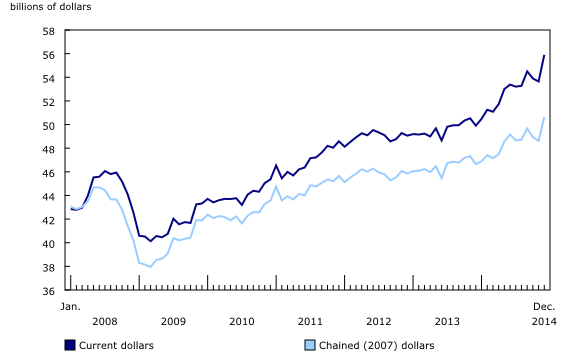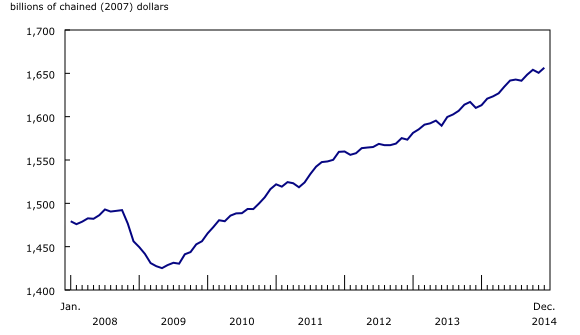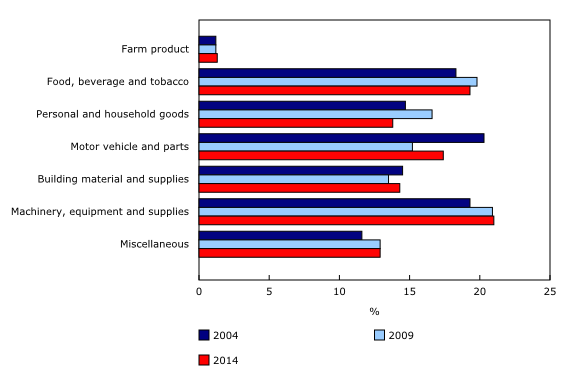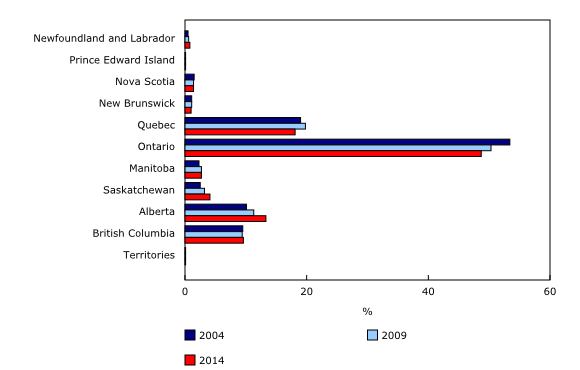Wholesale at a glance: An introduction to wholesale trade
Archived Content
Information identified as archived is provided for reference, research or recordkeeping purposes. It is not subject to the Government of Canada Web Standards and has not been altered or updated since it was archived. Please "contact us" to request a format other than those available.
Released: 2015-11-27
Wholesale trade comprises a group of diverse companies that typically operate "behind the scenes." This release sheds light on the sector by describing its role, why it matters and what it looks like in Canada.
What is wholesale trade?
Wholesale trade is a sector defined by the North American Industry Classification System (NAICS) as comprising "establishments primarily engaged in wholesaling merchandise, generally without transformation, and rendering services incidental to the sale of merchandise." In other words, the sector is composed of businesses that typically act as intermediaries, linking other sectors of the economy.
In general, wholesalers connect the farmers or manufacturers that produce goods with the companies or public institutions that need them, such as the factories buying inputs for their industrial processes or the retailers buying finished goods to sell to Canadian households. They also import goods from other countries and redistribute them within Canada, and export goods produced in Canada to other markets.
Many wholesalers sell merchandise in large quantities to retailers as well as to other businesses and institutions. However, some sell single units of capital or durable non-consumer goods such as heavy-duty vehicles, industrial machinery and farm equipment to the businesses that need them.
Wholesalers are also often experts in logistics, and can provide marketing and support services such as labelling, packaging and product training to the companies they serve.
One of the main tools for measuring wholesale trade in Canada is the Monthly Wholesale Trade Survey (MWTS). This survey program produces estimates of monthly sales by province and territory, as well as Canada-wide inventory levels, for almost all industries within the wholesale sector as defined by the NAICS.
There are three exclusions: oilseed and grain merchant wholesalers (NAICS 41112); petroleum and petroleum products merchant wholesalers (NAICS 412); and business-to-business electronic markets, and agents and brokers (NAICS 419). Statistics Canada gathers data for these industries from other sources, so they are excluded from the MWTS in order to minimize the response burden on Canadian companies. These excluded industries are covered by the Annual Wholesale Trade Survey.
Why does the wholesale trade sector matter?
Based on data from the MWTS, wholesalers sold an average of $52.9 billion worth of goods and held $65.9 billion in inventories per month in 2014. In comparison, on average, manufacturers sold $51.6 billion and retailers sold $42.1 billion worth of goods on a monthly basis during the same period.
The wholesale trade sector accounts for about 5% to 6% of gross domestic product (GDP), comparable with the retail trade sector. In 2014, wholesalers employed more than 775,000 people in an average month, or about 5.0% of all employees in Canada. In that year, on average, the wholesale sector employed a smaller share of people than the manufacturing sector (9.5%) and the retail sector (12.4%), but employed similar numbers to the finance and insurance sector (4.5%) and the transportation and warehousing sector (4.7%). People employed by wholesalers earned an average of $1,110 per week in 2014, approximately 19% higher than the national average of $935 per week and more than double that made by those working in retail trade ($542 per week).
In the area of capital spending, the wholesale sector accounted for 2.2% of non-residential building construction capital expenditures in Canada in 2013. This was a smaller amount than the shares of either the retail sector (9.6%) or the manufacturing sector (10.8%), but larger than the information and cultural industries sector (1.5%). In terms of capital expenditures on machinery and equipment, wholesalers accounted for 3.1%, similar to the retail sector (4.1%) but smaller than the manufacturing sector (13.1%).
In the same year, wholesalers accounted for 8.3% of total business enterprise research and development intramural expenditures, a far smaller share than manufacturers (42.1%), but a much larger share than retailers (0.4%).
Data on wholesale trade are key to understanding the broader Canadian economy. This is true not only because of the size of the sector, and its contribution to employment, capital expenditures and research and development expenditures, but also because wholesalers as intermediaries have relationships with most other sectors of the economy.
The 2008/2009 recession and subsequent recovery that were observed in the overall Canadian GDP were also pronounced in wholesale trade. Both wholesale sales and GDP decreased during the 2008/2009 recession, and had recovered to pre-recession levels by the end of January 2011. Both wholesale sales and GDP recorded annual growth between 2010 and 2014.
What do Canadian wholesalers do?
The way that wholesalers interact with other sectors of the economy varies significantly between the wholesale trade subsectors.
The largest subsector in the MWTS in 2014 was the machinery, equipment and supplies subsector, with average monthly sales of $11.1 billion. Wholesalers in this subsector typically distribute machinery and equipment to a variety of businesses, including those in the construction, mining, forestry, and manufacturing sectors, as well as to farmers, retailers and public institutions. The machinery and equipment needed by Canadian businesses are sometimes manufactured in other countries, so it is common for wholesalers in this subsector to import the machinery and parts they sell.
Wholesalers in the food, beverage and tobacco subsector typically sell to retailers and restaurants, linking these companies with the farmers and manufacturers that produce the goods desired by their customers. In this subsector, wholesalers sometimes import the goods they sell, and sometimes export food harvested or manufactured in Canada to the rest of the world. This subsector sold an average of $10.2 billion worth of goods monthly in 2014.
In the motor vehicle and parts subsector, which had average monthly sales of $9.2 billion in 2014, wholesalers are involved in both exporting and importing motor vehicles, which range from automobiles to heavy duty trucks and buses, as well as their parts. These wholesalers sell their goods to a wide variety of businesses, including retailers.
The building material and supplies subsector is one of the smaller subsectors, with average monthly sales of $7.6 billion in 2014. Most of these wholesalers distribute goods to retailers, manufacturers and other businesses, but there are some that export commodities such as lumber.
The next largest subsector in 2014 was personal and household goods, with average monthly sales of $7.3 billion. With the exception of wholesalers in the pharmaceuticals and pharmacy supplies industry, wholesalers in this subsector typically import a large share of the goods that they redistribute. It is typical of wholesalers in this subsector to primarily sell to retailers.
Wholesalers in the miscellaneous subsector are a very diverse group, accounting for on average $6.8 billion in monthly sales in 2014. They sell a wide variety of products to a variety of businesses, including retailers, manufacturers and farmers, and several export their goods to foreign markets.
Finally, wholesalers in the farm product subsector, the smallest subsector covered by the MWTS with average monthly sales of $709 million in 2014, specialize in the distribution of items such as live animals and nursery stock, both within Canada and to foreign markets.
Looking at the industries excluded from the MWTS, wholesalers of petroleum and petroleum products primarily sell to other wholesalers, although they do sell to foreign firms, manufacturers and retailers too. Wholesalers in the oilseed and grain industry, similar to other wholesalers in the farm product subsector, frequently export their goods to foreign markets.
The smallest excluded industry, business-to-business electronic markets and agents and brokers, is a small but diverse group that are united by the fact that they do not own the goods they sell. Instead, they sell goods owned by others for a fee or commission.
What does the wholesale trade sector look like in Canada?
In 2014, the three largest components of wholesale trade on the MWTS were the machinery, equipment and supplies subsector; the food, beverage and tobacco subsector; and the motor vehicle and parts subsector. Together, these subsectors accounted for an average of 58% of monthly sales.
In general, the distribution of wholesale sales among subsectors has been relatively stable since 2004, according to data from the MWTS. The notable exception is the motor vehicle and parts subsector, which recorded sharp changes in both the value and the share of its sales during the 2008/2009 recession. This subsector was the largest in 2004, representing on average 20% of monthly sales. By 2009, this subsector had fallen to the rank of fourth largest, representing on average 15% of monthly sales. From 2009 to 2014, sales in this subsector recovered and then surpassed their pre-recession levels, bringing it to the rank of third largest by 2014, when it accounted for an average of 17% of monthly wholesale sales.
According to MWTS data, wholesalers are heavily concentrated in Ontario, which accounted for on average 49% of monthly wholesale sales in 2014. Quebec (18%), Alberta (13%) and British Columbia (10%) were the next largest provinces, together accounting for an average 41% of monthly sales in 2014, less than the share of Ontario alone. Wholesale sales in the Atlantic provinces and the territories combined accounted for on average 3.5% of monthly wholesale sales in Canada during the same period.
The provincial distribution of monthly wholesale sales in 2014 was similar to that observed throughout the past decade. Although it remained the largest province by far, Ontario's average share of monthly sales decreased slightly, from 53% in 2004 to 49% in 2014.
Alberta and the other Western provinces saw their average shares of monthly sales grow slightly over this period, with Alberta posting the largest gain, rising from 10% in 2004 to 13% in 2014. The decline in the share of monthly sales coming from the motor vehicle and parts subsector, based largely in Ontario, and the growth of the machinery, equipment and supplies subsector in Alberta contributed to this shift in the provincial distribution.
Overall, wholesale trade comprises a diverse group of businesses that perform a variety of roles; they connect foreign firms to domestic ones, and provide the links between farmers, manufacturers, retailers, public institutions and other businesses in Canada. They may typically work "behind the scenes," but wholesalers are an integral part of the economy, and data on this sector are useful for understanding economic trends in Canada.
Note to readers
The public is also invited to chat with an expert on wholesale trade on Friday, November 27, 2015, from 12:30 to 13:30 p.m., Eastern time.
All monthly data in this release are seasonally adjusted and in current dollars, unless otherwise noted. For information on seasonal adjustment, see Seasonally adjusted data – Frequently asked questions.
Total wholesale sales expressed in volume are calculated by deflating current dollar values using relevant price indexes. The wholesale sales series in chained (2007) dollars is a chained Fisher volume index with 2007 as the reference year. For more information, see Sales in volume for Wholesale Trade.
Data sources
Data presented in this release were obtained from the following sources:
- Wholesale sales and inventories: Monthly Wholesale Trade Survey, CANSIM tables 081-0011, 081-0012 and 081-0015.
- Manufacturing sales: Monthly Survey of Manufacturing, CANSIM table 304-0014.
- Retail sales: Monthly Retail Trade Survey, CANSIM table 080-0020.
- Gross domestic product: Gross Domestic Product by Industry – National (Monthly), CANSIM tables 379-0029 and 379-0031.
- Employment: Survey of Employment, Payrolls and Hours, CANSIM table 281-0063.
- Capital and repair expenditures: Annual Capital and Repair Expenditures Survey, CANSIM table 029-0049.
- Business enterprise research and development intramural expenditures: Research and Development in Canadian Industry, CANSIM table 358-0024.
Contact information
For more information, contact us (toll-free 1-800-263-1136; 514-283-8300; STATCAN.infostats-infostats.STATCAN@canada.ca).
For analytical information, or to enquire about the concepts, methods or data quality of this release, contact Elspeth Hazell (613-951-8090; elspeth.hazell@canada.ca), Manufacturing and Wholesale Trade Division.
- Date modified:





